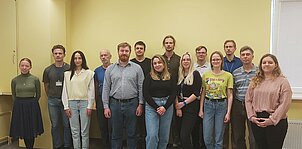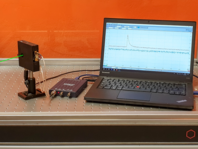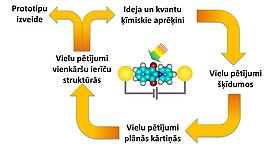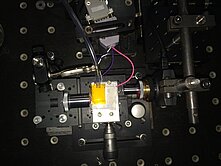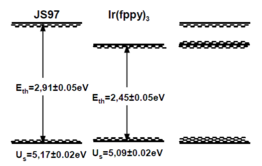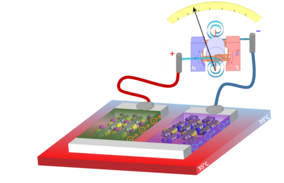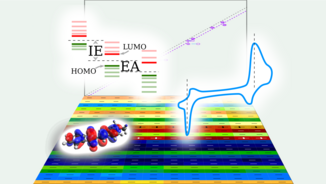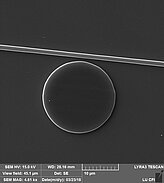Fundamental and applied research of organic molecules, materials and their structures are conducted by the Laboratory. The main goal of the research is to develop knowledge about the relationship between structure and properties in organic materials for next generation electronics and photonics. Using the concepts derived from the studies, new materials with improved properties are designed in close cooperation with Latvian and foreign chemists. Assessment and demonstration of the possible applications of novel materials is an important task of the laboratory. It covers light emitting diode, solar cells, solid state lasers, electro-optical and optical-optical modulators and field effect transistors. Persistently improved scientific skills, generated knowledge and technology within the Laboratory are the key elements for the development of organic the electronics and photonics in Latvia and Europe.
| Scientific degree | Name Surname | Position | Contact information |
|---|---|---|---|
| Dr.phys. | Aivars Vembris | Head of the laboratory and Leading researcher | Aivars.Vembris 67260787 |
| Ph.D. | Arturs Bundulis | Leading researcher | Arturs.Bundulis 67260787 |
| Dr.phys. | Kaspars Pudžs | Leading researcher | Kaspars.Pudzs 67260787 |
| Dr. phys. | Raitis Gržibovskis | Leading researcher | Raitis.Grzibovskis 67260787 |
| Dr.chem. | Anna Pidluzhna | Researcher | Anna.Pidluzhna 67260787 |
| Mg. | Natālija Tetervenoka | Researcher | Natalija.Tetervenoka 67260787 |
| Mg. | Andrejs Tokmakovs | Researcher | Andrejs.Tokmakovs 67187790 |
| Ph.D. | Bejan Hamawandi | Guest Researcher | Bejan.Hamawandi |
| Oleksandr Bezvikonnyi | Guest Researcher | Oleksandr.Bezvikonnyi | |
| Bc. | Anete Bērziņa | Research Assistant | Anete.Berzina 67260787 |
| Mg. | Patrīcija Paulsone | Research Assistant | Patricija.Paulsone 67260787 |
| Mg. | Oskars Bitmets | Research Assistant | Oskars.Bitmets 67260787 |
| Mg. | Elīna Laizāne | Research Assistant | Elina.Laizane 67260787 |
| Mg. | Viktorija Paramonova | Research Assistant | Viktorija.Paramonova |
| Bc. | Adriana Mauručaite | Research Assistant | Adriana.Maurucaite 67260787 |
| Marta Liedskalniņa | Laboratory Assistant | Marta.Liedskalnina 67260787 | |
| Mg. | Jānis Busenbergs | Laboratory Assistant | Janis.Busenbergs 67260787 |
| Margarita Anna Zommere | Laboratory Assistant | Margarita-Anna.Zommere | |
| Elizabete Prauliņa | Laboratory Assistant | Elizabete.Praulina | |
| Ralfs Lūkins | Laboratory Assistant | Ralfs.Lukins | |
| Ksenija Bobrovņika | Laboratory Assistant | Ksenija.Bobrovnika | |
| Renāte Čelmodejeva | Laboratory Assistant | Renate.Celmodejeva | |
| Kristians Draguns | Laboratory Assistant | Kristians.Draguns |
Organic materials for electronics and photonics are studied at the laboratory. Over long decades technologies for determining energy levels as well as conductivity in the light and in the dark, allowing to obtain general characteristics of electrical properties of amorphous and polycrystalline organic materials have been developed. Besides, linear optical (e.g., absorption and emission) and non-linear optical properties are studied in the laboratory for compounds in solution.
Quantum chemical calculations is one of directions pursued by the laboratory, which allows to comprehend the relationships between molecular structure and the optical and electric properties of the material constituted by them – before the synthesis itself. Deeper studies are carried out of energetic levels of the molecules, electronic transition energies and the interaction of light and matter in general.
The laboratory has many years experience in the thin film fabrication employing thermal evaporation in the vacuum and deposition from solution (spin coating, blade casting and dip casting). For such films, ionization energy of the molecules is determined using photoelectron yield spectroscopy method. Additionally, with spectral measurements of internal conductivity it is possible to determine the electron affinity of compounds. Electric properties are also determined for the thin films, as conductivity by the four-probe method and the charge carrier mobility by the time-of-flight method.
A great importance is given to the determination of optical properties. For thin films, absorption spectra, emission spectra and lifetime can be acquired at different temperatures, and also the photoluminescence quantum yield. This comprehensive information makes possible to judge about the applicability of certain organic compounds in organic light-emitting diodes, light-emitting electrochemical cells and solid state lasers. The laboratory has the required infrastructure for fabricating aforementioned structures of organic light-emitting diodes and characterizing them in an inert atmosphere spectrally and in terms of efficiency. All mentioned investigations of optical properties are essential to get insight into applicability of organic materials in light-amplifying systems, especially in organic solid state lasers. We have ability to carry out measurements of spontaneous emission using the variable stripe length method.
The laboratory has more than 30 years experience in the studies of non-linear optical activity of organic compounds. These studies involve measurements in both the solutions and thin films. Optical Kerr effect and two-photon absorption characteristics are determined, making it possible to select compounds for applications in optical switches and protective coatings. The closest acquaintance is with the second-order non-linear optical effects, of which research is focused on the electro-optic effect, hyper-Rayleigh scattering and second harmonic generation. These investigations allow selecting compounds and materials for applications in electro-optic modulators (transforming electric signals to optical ones), optical rectification, frequency change and elsewhere. The measurements are conducted by illuminating the substance in a liquid or solid solution with laser light.
As a practical facet of the aforementioned courses of research, waveguide structure studies are going on. Sophisticated optical structures are simulated theoretically and then embodied by fine optical lithography technique.
Thermoelectric effect is also studied in the laboratory. This includes investigations in Seebeck coefficient, thermal conductivity and electrical conductivity. Notably, all these measurements can be performed on the same sample, greatly improving the precision of determining the thermoelectric generator efficiency.
The conversion of solar energy to electricity is another research direction undertaken by the laboratory. It is connected both with classical organic solar cells and perovskite solar cells. The laboratory has skills and infrastructure for producing and characterizing such solar cells.
Recently started course of research are organic field-effect transistors. We consider both fabrication and characterization of said transistor devices.
Active projects:
The Recovery and Resilience Fund
Latvian Quantum Technologies Initiative
Latvian Council of Science
Horizon Europe
Towards an excellence centre on quantum photonics in Latvia (ToEQPL)
Accomplished projects:
EC Frameworks Projects
European Regional Development Fund
Next generation aggregation induced emission luminogens for artificial lighting sources (2019-2022)
Application assessment of novel organic materials by prototyping of photonic devices (2017-2020)
Materials and structures for tandem solar cells (2010-2013)
Development of polymer electro-optical modulator prototype (2011-2013)
European Regional Development Fund (LIAA administrated)
Thermoelectric radiation sensor (2018-2021)
European Social Fund
Design and study of glass forming low molecular weight organic materials for photonics (2013-2015)
Latvia - France Program “OSMOZE”
Surface plasmon enhanced amplified spontaneous emission of organic materials (2020-2021)
Latvian Council of Science
Development of X-ray sensitive hybrid organic-inorganic systems (2020-2022)
Development of time and polarization resolved kerr spectroscopy (2020-2021)
Postdoctoral
Blue thermally activated delayed fluorescence emitters for high efficiency OLEDs (2017-2020)
Organic light-emitting diodes based on heavy metal free emissive materials (2021-2023)
Latvia – Lithuania-Taiwan Trilateral Scientific Cooperation Program
Novel TADF materials and device architectures to enhance the performance of OLED (2019-2021)
National Research Program
MultIfunctional Materials and composItes, photonicS and nanotechnology (IMIS2) (2014-2018)
EEA and Norway Grants
EraNet
In recent year laboratory have successfully covered different organic material application areas. As several of the most important are investigations of physical properties for electro-optical and optical-optical modulators, solution processable organic light emitting diodes and lasers as well as thin film thermoelectric generators. Each of research subjects is covered by the European Regional Development Funds or European Research programs. Laboratory has started few projects with the aim to use previously obtained fundamental knowledge to develop at least TRL6 level prototype for future commercialisation. Most important achievements in each field are fallowing.
One of the most challenging aspects in nonlinear optical (NLO) material research field is correct estimation of characteristic coefficients for various NLO effects. In recent years our scientific team published a work regarding measurements of thin film electro-optical coefficient and how to separate it from multiple internal reflection and piezo or electrostrictive thickness changes. Besides this we have moved towards device designing implementing novel organic materials, based on our own structure-properties studies for NLO applications. We have already demonstrated organic electro-optical waveguide switch and are moving towards all-optical organic devices.
Laboratory has more focused on solution processed organic light emitting diode (OLED) and light amplification systems. Subject of investigations is molecular glasses where bulky group is attached to active part of the molecule. Such approach reduced the intermolecular interaction between the molecules which improve optical properties of thin films. We have shown the light emission in the neat films where emission is fully quenched in the compound without bulky groups. It results in the red emitting laser dyes where amplified spontaneous emission excitation threshold energy in neat films is lower than 25 mJ/cm2 and below 10 mJ/cm2 in host-guest systems. Molecular glasses also facilitate the preparation and overall performance of OLED. In recent works we have shown the improved properties of OLED prepared from metal complex - molecular glasses compared to its polycrystalline analogues. Additionally was shown specific interaction between bulky groups which results in formation of crystal with high emittance yield.
We have demonstrated that by appropriate doping it is possible to obtain thermoelectrically active organic thin films of both p- and n-types. We have prepared p-type TTT iodide thin films with a power factor of 0.52 μW m−1K−2, and n-type TCNQ:TTT films with a power factor of 0.33 μW m−1K−2. This achievement has allowed demonstration of the proof of concept for planar thin film thermoelectric generator based on organic p- and n-type materials operating under near ambient conditions. We have developed the sample preparation and measurement workflow, to determine the main thermoelectric characteristics (Seebeck coefficient, electrical conductivity and thermal conductivity) of thin films on one sample, therefore minimizing errors for power factor and figure of merit ZT calculations. We have succeeded in implementing a procedure for identifying potentially most suitable low molecular weight compounds for the generation of thermoelectric devices using only a small amount of substances.
Many years of quantum chemical calculations have resulted in vast amount of information. Various properties (molecular geometries and atomic charges, polarizabilities and hyperpolarizabilities, optical absorption and luminescence spectra, ionization energies and electron affinities) were computed for over 500 mostly original compounds and stored in a database. In the future, this database will be made available to the public. Also, during these studies we accumulated knowledge in selection of computational methods for various types of results based on statistical reasoning (effect decomposition methodology), part of which has already been published.
Latvia:
- Riga Technical University;
- Latvian Institute of Organic Synthesis;
- Latvian Institute of Physical Energetics;
- University of Daugavpils.
Lithuania:
- University of Vilnius (prof. S. Juršėnas);
- Kaunas University of Technology (prof. J. V. Gražulevičius, prof. S. Grigalevičius, and prof. Vytautas Getautis);
- Center for Physical Sciences and Technology (prof. L. Valkūnas and prof. V. Gulbinas).
France:
- Paris Institute of Nanosciences (prof. N. Witkowski);
- Université de technologie de Troyes (prof. P. M. Adam).
United Kingdom:
- University of Nottingham (prof. S. Woodward).
Germany:
- Julius-Maximilians Universität Würtzburg (prof. J. Pflaum).
Bulgaria:
- Institute of Organic Chemistry, Bulgarian Academy of Sciences (prof. V. Dimitrov).
Moldova:
- Technical University of Moldova (prof. A. Casian).
Estonia:
- Tallinn University of Technology (Ilona Oja Acik)
Norway:
- Institute for Energy Technology (Smagul Karazhanov)
V. V. Kim, A. Bundulis, V. S. Popov, N. A. Lavrentyev, A. A. Lizunova, I. A. Shuklov, V. P. Ponomarenko, J. Grube, R. A. Ganeev, Third-order optical nonlinearities of exfoliated Bi2Te3 nanoparticle films in UV, visible and near-infrared ranges measured by tunable femtosecond pulses, Opt. Express, 2022, 30, 6970-6980. DOI: 10.1364/OE.449490
A. Bundulis, J. Mikelsone, M. Rutkis, Impact of silver nanoparticle two-photon resonance on Kerr effect of organic dye solutions, J. Opt. Soc. Am. B, 2022, 39, 22-31. DOI: 10.1364/JOSAB.440997
K. Traskovskis, A. Sebris, I. Novosjolova, M. Turks, M. Guzauskas, D. Volyniuk, O. Bezvikonnyi, J. V. Grazulevicius, A. Mishnev, R. Grzibovskis A. Vembris, All-organic fast intersystem crossing assisted exciplexes exhibiting sub-microsecond thermally, activated delayed fluorescence, J. Mater. Chem. C, 2021, 9, 4532-4543. DOI: 10.1039/d0tc05099g
E. Zarins, J. Pervenecka, E. Misina, O. Bezvikonnyi, A. Vembris, K. Balodis, D. Volyniuk, J. V. Grazulevicius, V. Kokars, HAPPY Dyes as Light Amplification Media in Thin Films, J. Org. Chem., 2021, 86(4), 3213–3222. DOI: 10.1021/acs.joc.0c02574
A. Ruduss, V. Kokars, N. Tetervenoka, A. Vembris, K. Traskovskis, Effects of steric encumbrance of iridium(III) complex core on performance of solutionprocessed organic light emitting diodes, RSC Adv., 2020, 10, 27552-27559. DOI: 10.1039/d0ra04652c
A. Bundulis, I. Mihailovs, M. Rutkis, Origin of the Kerr effect: investigation of solutions by polarization-dependent Z-scan, J. Opt. Soc. Am. B, 2020, 37, 1806-1811. DOI: 10.1364/JOSAB.389520
E. Nitiss , A. Bundulis, A. Tokmakovs, J. Busenbergs, M. Rutkis, All-Organic Waveguide Sensor for Volatile Solvent Sensing, Photonic Sens. 2019, 9, 356–366. DOI: 10.1007/s13320-019-0543-z
K. Pudzs, A. Vembris, M. Rutkis, S. Woodward. Thin Film Organic Thermoelectric Generator Based on Tetrathiotetracene. Adv. Electron. Mater., 2017, 3(2), 1600429. DOI: 10.1002/aelm.201600429
A. Vembris, E. Zarins, V. Kokars. Stimulated emission and optical properties of pyranyliden fragment containing compounds in PVK matrix. Opt. Laser Technol., 2017, 95, 74–80. DOI: 10.1016/j.optlastec.2017.04.021
E. Nitiss, A. Tokmakovs, K. Pudzs, J. Busenbergs, M. Rutkis. All-organic electro-optic waveguide modulator comprising SU-8 and nonlinear optical polymer. Opt. Express, 2017, 25(25), 31036–31044. DOI: 10.1364/OE.25.031036
E. Nitiss, E. Titavs, K. Kundzins, A. Dementjev, V. Gulbinas, M. Rutkis. Poling induced mass transport in thin polymer films. J. Phys. Chem. B, 2013, 117(9), 2812–2819. DOI: 10.1021/jp310961a
K. Traskovskis, I. Mihailovs, A. Tokmakovs, A. Jurgis, V. Kokars, M. Rutkis. Triphenyl moieties as building blocks for obtaining molecular glasses with nonlinear optical activity. J. Mater. Chem., 2012, 22(22), 11268–11276. DOI: 10.1039/c2jm30861d
I. Muzikante, V. Parra, R. Dobulans, E. Fonavs, J. Latvels, M. Bouvet. A novel gas sensor transducer based on phthalocyanine heterojunction devices. Sensors, 2007, 7(11), 2984–2996, DOI: 10.3390/s7112984
E. A. Silinsh, V. Čápek. Organic Molecular Crystals. Interaction, Localization and Transport Phenomena. American Institute of Physics, 1994, 250p.
- Method for producing emission layer based on compounds of rare-earth elements and organic light-emitting diodes, RU2657497C1, 14.06.2018
- Light-emitting diode with an emission layer on the basis of compounds of rare earth elements, WO2018208186A1, 15.11.2018
- Photosensitive bulk heterojunction layer with indandiene derivative MeSBI for organic solar cells and light sensors, production method of the layer, LV15056B, 20.03.2016
- Polymeric nonlinear poled material, LV14949A, 20.01.2015
- Device and method for polarization of thin polymer layers in restricted surface area, LV14755A, 20.11.2013
Laboratory homepage
